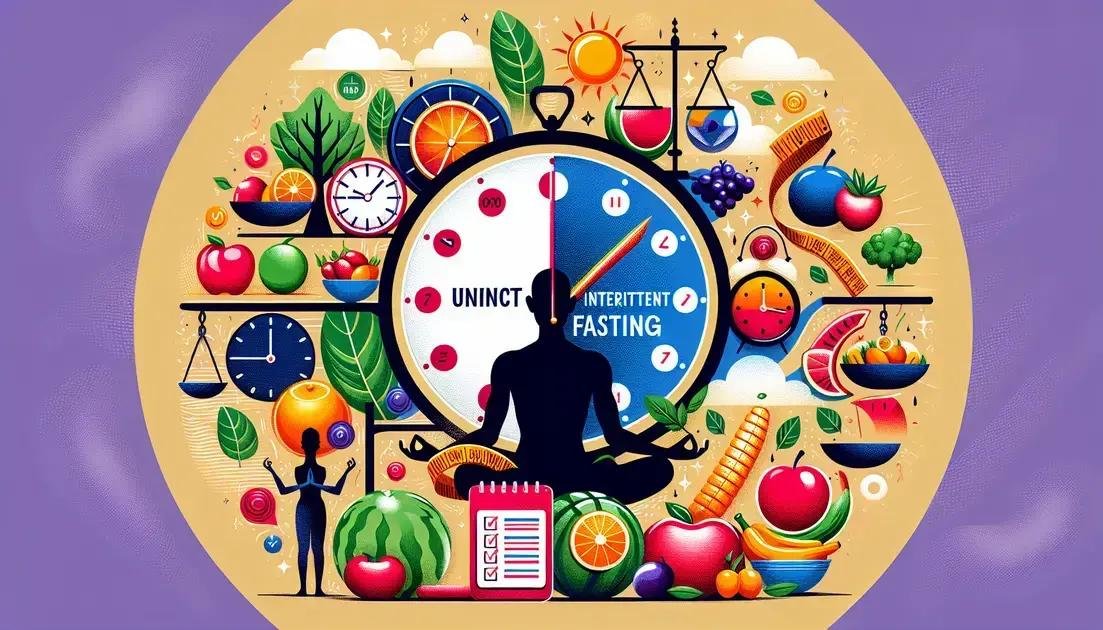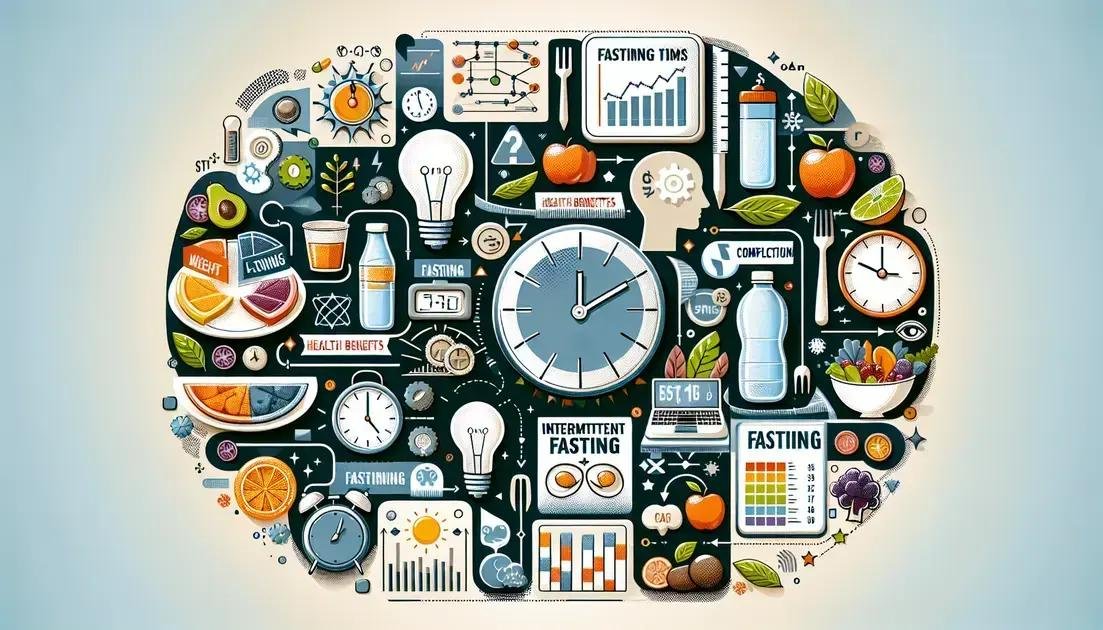
“Unlocking Intermittent Fasting: Benefits, Pitfalls, and Lifestyle Tips”
-
Lucas Souza
-
8, janeiro, 2025
Topics
 Shared
Shared
Intermittent fasting: pros, cons, and best practices have become one of the most talked-about topics in the world of diets and wellness.
This eating pattern doesn’t specify which foods you should eat but rather when you should eat them, offering a different perspective on nutrition and health.
By alternating between fasting and eating periods, it seeks to provide numerous benefits, from weight management to improved mental clarity.
Dive into our comprehensive guide as we explore the multifaceted world of intermittent fasting, taking into account the important factors like who it is best suited for, what misconceptions exist, and practical tips for better results.
Understanding Intermittent Fasting
Intermittent fasting involves cycling between periods of eating and fasting. This approach does not dictate specific foods but focuses on when to eat them.
Popular methods include the 16/8 method, where you fast for 16 hours and eat during an 8-hour window. Many individuals use it to simplify their dietary choices and improve their health.
Benefits of Intermittent Fasting
Research suggests that intermittent fasting may enhance metabolic health, improve fat loss, and support cellular repair mechanisms. By allowing the body to rest from digestion, it’s believed to promote various beneficial physiological processes.
Health Benefits of Intermittent Fasting

Intermittent fasting offers a range of health benefits that many people find appealing. First, this eating pattern can help with weight loss as it encourages a reduction in calorie intake while still allowing flexibility in food choices. Moreover, studies show that it can improve metabolic health by enhancing insulin sensitivity, which ultimately reduces the risk of type 2 diabetes.
Another significant benefit is its potential to boost brain function. Research indicates that intermittent fasting may promote the production of brain-derived neurotrophic factor (BDNF), a protein linked to cognitive enhancement and a reduced risk of neurodegenerative diseases.
Additionally, intermittent fasting has shown promise in reducing inflammation and improving heart health. It can help lower cholesterol levels and blood pressure, contributing to overall cardiovascular wellness.
Fasting periods also promote cellular repair processes, such as autophagy, where the body cleans out damaged cells and regenerates new ones. This process is linked to anti-aging benefits, making fasting an intriguing approach for those seeking longevity.
Overall, the health benefits of intermittent fasting range from weight management to improved brain function, making it a compelling option for many.
Potential Risks and Cons
While intermittent fasting has benefits, there are also potential risks and cons associated with this diet plan. First, it might not be suitable for everyone. Some people experience negative effects like nutrient deficiencies due to limited eating windows. Additionally, individuals with certain medical conditions, such as diabetes or eating disorders, should approach fasting cautiously.
Another issue is the possibility of overeating during eating periods. This can lead to weight gain rather than loss, which can be frustrating for those trying to improve their health. It’s important to focus on nutrient-dense foods when breaking a fast.
A strong feeling of hunger can also impact mood and concentration, especially during the adjustment period. Some may find it difficult to concentrate on daily tasks while adapting to a fasting schedule.
Furthermore, intermittent fasting can affect social engagements. People may feel isolated when their eating patterns do not align with family or friends, which can complicate social interactions.
In summary, while intermittent fasting has its advantages, it’s critical to consider potential drawbacks and individual health needs before starting this eating pattern.
Different Methods of Fasting

There are several different methods of fasting that individuals can choose from, each offering unique benefits and flexibility. One of the most popular approaches is the 16/8 method, which involves fasting for 16 hours and eating during an 8-hour window. This method is often simple to follow, as it can be aligned with a person’s sleep schedule.
Another method is the 5:2 diet, where individuals consume a normal diet for five days and limit calorie intake to around 500-600 calories for two non-consecutive days. This can make fasting more manageable, as the restricted days allow for some food intake.
Alternate day fasting is another variation where individuals switch between a day of normal eating and a day of fasting. This method can be more challenging but may yield significant benefits in weight loss and metabolic health.
Warrior diet is a more extreme approach, where individuals eat small amounts of raw fruits and vegetables during the day and eat one large meal at night. While effective for some, it requires significant commitment and may not be suited for everyone.
Lastly, spontaneous meal skipping allows individuals to skip meals when they feel unhungry, promoting flexibility. This approach can lead to natural fasting patterns based on personal comfort rather than strict schedules.
Each method of fasting can vary in effectiveness based on individual lifestyles and preferences, so it’s important to choose a method that fits seamlessly into daily routines.
Who Should Avoid Intermittent Fasting?
Who should avoid intermittent fasting? It’s essential to recognize that this eating pattern is not suitable for everyone. Certain groups of individuals may experience adverse effects or complications from this practice. Pregnant or breastfeeding women should consult their healthcare provider before attempting any fasting regimen, as nutrition is crucial during these stages.
Additionally, people with a history of eating disorders like anorexia or bulimia should avoid intermittent fasting. Restrictive eating approaches can trigger unhealthy behaviors and exacerbate these conditions.
Individuals with medical conditions such as diabetes may also need to steer clear, particularly those who use insulin or other medications that affect blood sugar levels. Fasting can lead to dangerously low blood sugar if not managed correctly.
Children and teenagers should not attempt intermittent fasting, as they require consistent nutrition for proper growth and development. Older adults with underlying health issues should also consult their doctors before considering fasting.
Lastly, those with a sedentary lifestyle or significant stress may find fasting challenging, as it can lead to increased fatigue or irritability. In these cases, a more balanced eating pattern might be a better choice.
Intermittent Fasting and Weight Loss

Intermittent fasting and weight loss are closely linked, as this eating pattern can effectively help people shed unwanted pounds.
When practicing intermittent fasting, individuals often consume fewer calories overall, which may lead to weight loss without the need for complex diet plans.
One key mechanism by which intermittent fasting aids in weight loss is through improved insulin sensitivity. Lower insulin levels during fasting periods can enhance the body’s ability to burn fat for energy instead of storing it. This metabolic shift can result in a reduction of body fat over time.
Moreover, intermittent fasting encourages the body to use stored fat as a fuel source, particularly during extended fasting periods. This can accelerate fat oxidation, making it an efficient way to lose weight.
Studies have shown that individuals who engage in intermittent fasting often experience changes in their body composition. Along with weight loss, many report a leaner physique resulting from fat loss while maintaining muscle mass. This is because fasting can stimulate processes that promote muscle preservation during weight loss.
While intermittent fasting can be effective for weight loss, it’s essential to focus on nutrient-dense foods during eating windows. This ensures the body receives essential vitamins and minerals while maximizing health benefits. Foods rich in protein, healthy fats, and fiber can contribute significantly to a successful weight loss journey.
Impact on Mental Clarity and Focus
Impact on mental clarity and focus is a significant benefit of intermittent fasting that many individuals experience. During fasting periods, the body undergoes a range of hormonal changes, including an increase in norepinephrine. This hormone helps to enhance alertness, focus, and overall cognitive function.
Many participants in intermittent fasting report improved concentration and mental clarity. This can be attributed to the body’s shift in energy sources, as it begins to burn fat instead of relying on frequent food intake. The brain can benefit from this change, as fat is a more stable energy source, which allows for better mental performance.
Furthermore, fasting may stimulate the production of brain-derived neurotrophic factor (BDNF), a protein that supports brain health. Increased levels of BDNF are associated with improved mood, memory, and learning capabilities.
However, the effects on mental clarity can vary from person to person. Some may initially feel brain fog or lethargy as their body adapts to this new eating pattern. As they adjust, many report a noticeable improvement in focus.
It’s important to drink plenty of water and consider electrolytes during fasting to stay hydrated, which can also contribute to enhanced mental alertness. Overall, intermittent fasting can have a profound impact on mental clarity and focus for those who practice it regularly.
Best Practices to Follow

Best practices to follow when engaging in intermittent fasting can make a significant difference in your success and overall experience. First, it’s essential to choose a method that fits well with your lifestyle. Popular options like the 16/8 method are often easier to integrate into daily routines.
Stay hydrated during fasting periods by drinking water, herbal teas, or black coffee. This will help curb hunger and maintain your energy levels. Listening to your body is crucial. If you feel weak or unwell, consider adjusting your fasting schedule or consulting a healthcare professional.
During eating windows, focus on nutrient-dense foods like lean proteins, whole grains, healthy fats, and plenty of fruits and vegetables. Avoid processed foods high in sugar and unhealthy fats, as these can lead to overeating and poor nutritional choices.
Prepare meals in advance to make healthy eating easier during your feeding windows. This practice helps to resist the temptation to choose less nutritious options when hunger strikes.
It’s also beneficial to incorporate regular physical activity into your routine. This not only supports weight loss but also enhances overall health and well-being. Aim for a mix of cardio and strength training, which can further increase metabolic health.
Lastly, keep a journal to track your progress and feelings during intermittent fasting. This can help you notice trends and understand how your body responds, making it easier to adjust your approach when necessary.
Common Misconceptions
Common misconceptions about intermittent fasting can lead to misunderstandings about its effectiveness and safety. One prevalent myth is that fasting will cause muscle loss. However, many studies suggest that muscle loss is minimal when fasting is combined with strength training and sufficient protein intake during eating periods.
Another misconception is that intermittent fasting is synonymous with starvation. In reality, it’s different because fasting involves planned eating windows rather than prolonged deprivation of food. Many people find that they actually enjoy their meals more when they are mindful of when they eat.
Some believe that intermittent fasting means you can eat anything during eating windows. This is not true; while one may have more flexibility, focusing on nutrient-dense foods is still essential for health and optimal results.
Additionally, many think fasting is unsuitable for everyone. While it isn’t recommended for certain groups, like pregnant women or those with specific medical conditions, most healthy adults can safely practice intermittent fasting.
There’s also a perception that hunger during fasting is unbearable. Many individuals report that after an adjustment period, their hunger levels stabilize, and they often feel less hungry than expected.
Lastly, some people think intermittent fasting is a quick-fix diet. In truth, it’s a lifestyle choice that requires commitment and patience for lasting results.
Intermittent Fasting vs Traditional Dieting

Intermittent fasting vs traditional dieting represents two distinct approaches to weight management and health improvement.
Traditional dieting typically involves continuous calorie restriction, where individuals count calories and monitor food intake daily. This approach can often feel rigid and may lead to feelings of deprivation.
On the other hand, intermittent fasting focuses more on when you eat rather than what you eat. This method allows for periods of normal eating, which can make it easier for many people to adhere to long-term. With intermittent fasting, there’s less focus on calorie counting, as the fasting periods naturally limit the time available to eat.
Another key difference is the psychological aspect. Traditional diets often involve strict rules and can lead to a cycle of yo-yo dieting. Many find that intermittent fasting can be more liberating, as it eliminates the need for daily food tracking and lets individuals enjoy meals more freely during eating windows.
When it comes to metabolic effects, both methods can be effective for weight loss. However, some studies suggest that intermittent fasting may enhance fat metabolism and promote better hormonal balance, leading to improved insulin sensitivity.
Furthermore, the social aspect of eating can differ. Traditional diets may lead to social isolation due to restrictive eating practices, while intermittent fasting often allows for social meals if timed correctly.
Ultimately, choosing between intermittent fasting and traditional dieting largely depends on individual preferences, lifestyle, and health goals.
Adjusting to an Intermittent Fasting Lifestyle
Adjusting to an intermittent fasting lifestyle can be a smooth transition for many individuals, but it requires some planning and patience.
First, it’s important to start gradually. Instead of jumping into a strict fasting schedule, consider beginning with a shorter fasting window, such as 12 hours, and gradually increasing it as your body adapts.
During this adjustment phase, listening to your body is key. Pay attention to hunger cues and energy levels. Some days may be easier than others, and that’s normal. If you feel fatigued or overly hungry, it’s okay to reduce your fasting window temporarily.
Staying hydrated is crucial while you adjust. Drinking plenty of water, herbal teas, or black coffee can help manage hunger and keep your energy up. It can also deter feelings of lethargy as your body learns to utilize its fat stores for energy.
Meal planning is another effective strategy. Having healthy, nutrient-dense foods readily available for eating windows can prevent impulsive choices and ensure you’re fueling your body properly. Focus on incorporating a balance of proteins, healthy fats, and carbohydrates from whole food sources.
Establishing a routine can also help your body adapt more easily. Setting regular fasting and eating times reinforces your new eating pattern, making it easier to stick with it long-term. Moreover, consider tracking your progress in a journal, noting any changes in energy, mood, and other health markers.
Finally, commitment and persistence are important. It may take some time to fully adjust to an intermittent fasting lifestyle, so be patient with yourself. With dedication, many people find it becomes a natural part of their daily routine.
Tips for Success

Tips for success in intermittent fasting can help individuals achieve their health goals effectively. First, it’s crucial to set realistic goals. Instead of expecting drastic changes immediately, aim for gradual progress to make the transition smoother.
Staying well-hydrated is essential during both fasting and eating periods. Drink plenty of water, herbal teas, or black coffee to manage hunger and maintain energy levels. Proper hydration also helps prevent headaches and fatigue that can arise after starting fasting.
Planning your meals is another effective strategy. Prepare healthy, nutrient-dense meals in advance to avoid unhealthy choices during eating windows. Focus on foods rich in protein, healthy fats, and fiber to keep you full longer.
Consider embracing a flexible approach to fasting. While some individuals thrive on strict schedules, others may find success with a more spontaneous method. Listen to your body and adjust your fasting windows as needed.
Keep track of your progress, noting changes in weight, mood, and energy. This can provide motivation and help identify what works best for you.
Lastly, don’t forget to connect with others who share similar goals. Online communities or support groups can provide encouragement and share tips that enhance your fasting experience.
Conclusion
Intermittent fasting offers a unique approach to health and wellness, distinguishing itself from traditional dieting methods.
With various methods to choose from, individuals can find a fasting schedule that suits their lifestyle while enjoying benefits such as improved weight management, enhanced mental clarity, and potential health improvements.
However, it is essential to understand the associated risks and who should avoid this eating pattern.
By incorporating best practices and focusing on nutrient-dense meals, individuals can successfully navigate their intermittent fasting journey.
Ultimately, patience and commitment will help achieve long-term results and foster a healthier lifestyle.
FAQ – Understanding Intermittent Fasting
What is intermittent fasting?
Intermittent fasting is an eating pattern that cycles between periods of eating and fasting. It does not dictate what foods to eat but rather when to eat them.
What are the benefits of intermittent fasting?
Benefits include weight loss, improved metabolic health, increased brain function, and enhanced cellular repair processes.
Are there any risks associated with intermittent fasting?
Yes, potential risks include nutrient deficiencies, increased hunger, and possible negative effects for individuals with specific medical conditions.
What are the different methods of intermittent fasting?
Common methods include the 16/8 method, the 5:2 diet, alternate day fasting, and the warrior diet.
Who should not practice intermittent fasting?
Individuals such as pregnant or breastfeeding women, those with eating disorders, and people with certain medical conditions should avoid fasting.
Does intermittent fasting help with weight loss?
Yes, intermittent fasting can help with weight loss by promoting reduced calorie intake and encouraging fat burning.
Can intermittent fasting improve mental clarity?
Many individuals report enhanced mental clarity and focus when practicing intermittent fasting due to hormonal changes during fasting periods.
What are the best practices for successful intermittent fasting?
Start gradually, stay hydrated, plan meals in advance, listen to your body, and keep a journal to track progress.
What are common misconceptions about intermittent fasting?
Common misconceptions include the belief that fasting causes muscle loss and that fasting is synonymous with starvation.
How does intermittent fasting differ from traditional dieting?
Intermittent fasting focuses on when to eat rather than what to eat, allowing for flexibility and often avoiding the strict rules of traditional diets.
How can I adjust to an intermittent fasting lifestyle?
Start slowly, stay hydrated, plan meals, and establish a routine while paying attention to your body’s signals.
What tips can ensure success with intermittent fasting?
Set realistic goals, stay hydrated, plan meals, track progress, and connect with others for support.
 Return blog
Return blog